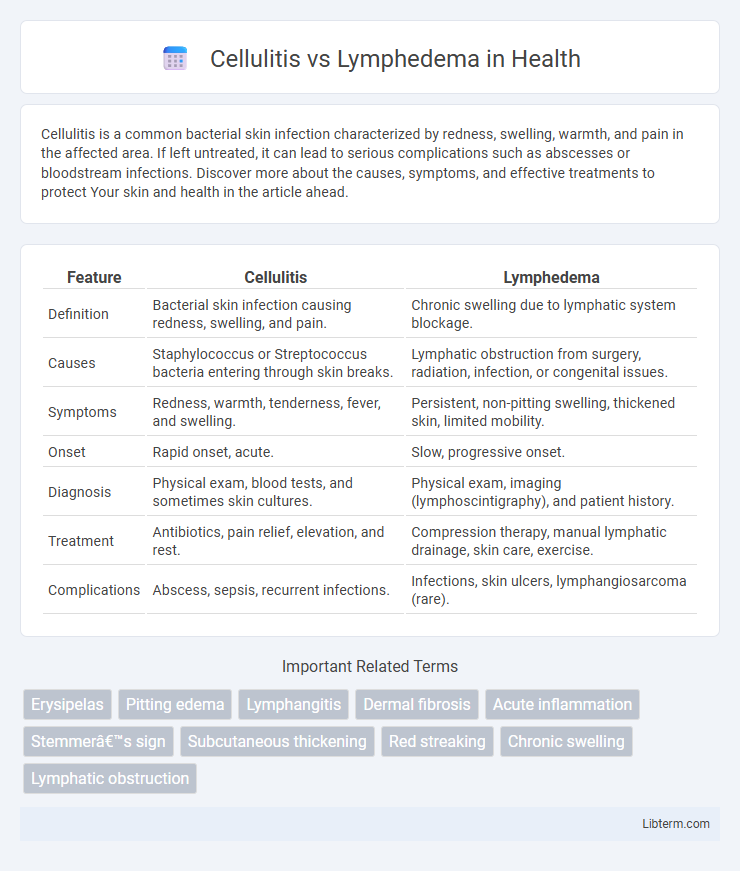Cellulitis is a common bacterial skin infection characterized by redness, swelling, warmth, and pain in the affected area. If left untreated, it can lead to serious complications such as abscesses or bloodstream infections. Discover more about the causes, symptoms, and effective treatments to protect Your skin and health in the article ahead.
Table of Comparison
| Feature | Cellulitis | Lymphedema |
|---|---|---|
| Definition | Bacterial skin infection causing redness, swelling, and pain. | Chronic swelling due to lymphatic system blockage. |
| Causes | Staphylococcus or Streptococcus bacteria entering through skin breaks. | Lymphatic obstruction from surgery, radiation, infection, or congenital issues. |
| Symptoms | Redness, warmth, tenderness, fever, and swelling. | Persistent, non-pitting swelling, thickened skin, limited mobility. |
| Onset | Rapid onset, acute. | Slow, progressive onset. |
| Diagnosis | Physical exam, blood tests, and sometimes skin cultures. | Physical exam, imaging (lymphoscintigraphy), and patient history. |
| Treatment | Antibiotics, pain relief, elevation, and rest. | Compression therapy, manual lymphatic drainage, skin care, exercise. |
| Complications | Abscess, sepsis, recurrent infections. | Infections, skin ulcers, lymphangiosarcoma (rare). |
Understanding Cellulitis: Causes and Symptoms
Cellulitis is a bacterial skin infection primarily caused by Streptococcus and Staphylococcus species, often entering through cuts or insect bites. It presents with symptoms such as redness, swelling, warmth, and pain in the affected area, sometimes accompanied by fever and chills. Unlike lymphedema, which involves chronic fluid retention and tissue swelling due to lymphatic system impairment, cellulitis is an acute inflammatory response requiring prompt antibiotic treatment to prevent complications.
What Is Lymphedema? Key Features Explained
Lymphedema is a chronic condition characterized by the accumulation of lymphatic fluid, leading to swelling predominantly in the arms or legs due to impaired lymphatic drainage. Key features include persistent swelling, skin changes such as thickening and fibrosis, and a high risk of recurrent infections. Unlike cellulitis, which is an acute bacterial infection causing redness, warmth, and pain, lymphedema results from lymphatic system dysfunction and requires long-term management strategies including compression therapy and physical drainage techniques.
Comparing Risk Factors: Cellulitis vs Lymphedema
Cellulitis risk factors include skin trauma, compromised immunity, and bacterial infection predominantly by Streptococcus and Staphylococcus species. Lymphedema arises primarily from lymphatic obstruction due to surgery, radiation, or congenital anomalies, leading to chronic fluid accumulation and tissue swelling. Both conditions share obesity and venous insufficiency as common risk factors, but cellulitis typically initiates with an acute infectious process, whereas lymphedema develops from impaired lymphatic drainage.
Clinical Presentation: Telling the Conditions Apart
Cellulitis typically presents with acute onset of localized redness, warmth, swelling, and tenderness, often accompanied by fever and systemic symptoms, indicating infection. Lymphedema features chronic, non-pitting swelling due to lymphatic fluid accumulation, usually without redness or systemic signs, and is often associated with a history of lymphatic damage or obstruction. Differentiating the two relies on assessing the presence of infection markers in cellulitis versus the progressive, painless swelling characteristic of lymphedema.
Diagnosis: How Doctors Differentiate Cellulitis from Lymphedema
Doctors differentiate cellulitis from lymphedema primarily through clinical examination and patient history, noting that cellulitis presents with acute redness, warmth, and pain often accompanied by systemic symptoms like fever. Lymphedema is characterized by chronic, non-pitting swelling without erythema or systemic signs, typically resulting from lymphatic obstruction or damage. Diagnostic tools such as ultrasound, Doppler imaging, and laboratory tests including elevated white blood cell count help confirm cellulitis, while lymphoscintigraphy is used to assess lymphatic function in lymphedema.
Complications: Short and Long-Term Effects
Cellulitis often leads to severe bacterial infections causing swelling, redness, and pain with the risk of sepsis or abscess formation as short-term complications. Lymphedema results from impaired lymphatic drainage causing persistent limb swelling, which can progress to skin thickening, fibrosis, and increased susceptibility to recurrent infections long-term. Both conditions may cause chronic discomfort and impaired mobility, but lymphedema's long-term tissue changes significantly increase the risk of secondary infections and functional disability.
Treatment Options for Cellulitis
Effective treatment options for cellulitis primarily include systemic antibiotics targeting common causative bacteria such as Streptococcus and Staphylococcus species. Oral antibiotics like cephalexin or dicloxacillin are typically prescribed for mild cases, while intravenous antibiotics such as ceftriaxone or vancomycin are reserved for severe infections or hospitalized patients. Supportive care also involves limb elevation and pain management to reduce inflammation and promote healing.
Managing and Treating Lymphedema
Managing lymphedema involves consistent use of compression garments, meticulous skin care, and specialized physical therapy such as manual lymphatic drainage to reduce swelling and prevent infections. Treatment plans often include exercises designed to promote lymphatic flow and maintaining a healthy lifestyle to support immune function. Early intervention and adherence to prescribed therapies are crucial to minimizing complications and improving quality of life for patients with lymphedema.
Preventing Recurrence and Flare-Ups
Preventing recurrence and flare-ups of cellulitis and lymphedema requires meticulous skin care, including daily moisturizing and prompt treatment of cuts or insect bites to reduce infection risk. Compression therapy and regular limb elevation are essential in managing lymphedema to improve lymphatic flow and minimize swelling, which lowers the likelihood of cellulitis. Consistent monitoring by healthcare providers, combined with antibiotics for infections and adherence to prescribed lymphatic drainage exercises, further reduces complications and promotes long-term skin health.
When to Seek Medical Attention
Seek medical attention for cellulitis if you experience rapidly spreading redness, swelling, warmth, severe pain, fever, or chills, as these signs may indicate a serious bacterial infection requiring prompt antibiotic treatment. In cases of lymphedema, consult a healthcare provider if there is persistent swelling, skin changes such as thickening or hardening, frequent infections, or if swelling worsens and causes discomfort or mobility issues. Early diagnosis and treatment of both conditions are crucial to prevent complications like tissue damage or systemic infection.
Cellulitis Infographic

 libterm.com
libterm.com